Specific and differential activation of mitogen-activated protein kinase cascades by unfamiliar taste in the insular cortex of the behaving rat
- PMID: 9822758
- PMCID: PMC6793319
- DOI: 10.1523/JNEUROSCI.18-23-10037.1998
Specific and differential activation of mitogen-activated protein kinase cascades by unfamiliar taste in the insular cortex of the behaving rat
Abstract
Rats were given to drink an unfamiliar taste solution under conditions that result in long-term memory of that taste. The insular cortex, which contains the taste cortex, was then removed and assayed for activation of mitogen-activated protein kinase (MAPK) cascades by using antibodies to the activated forms of various MAPKs. Extracellular responsive kinase 1-2 (ERK1-2) in the cortical homogenate was significantly activated within <30 min of drinking the taste solution, without alteration in the total level of the ERK1-2 proteins. The activity subsided to basal levels within <60 min. In contrast, ERK1-2 was not activated when the taste was made familiar. The effect of the unfamiliar taste was specific to the insular cortex. Jun N-terminal kinase 1-2 (JNK1-2) was activated by drinking the taste but with a delayed time course, whereas the activity of Akt kinase and p38MAPK remained unchanged. Elk-1, a member of the ternary complex factor and an ERK/JNK downstream substrate, was activated with a time course similar to that of ERK1-2. Microinjection of a reversible inhibitor of MAPK/ERK kinase into the insular cortex shortly before exposure to the novel taste in a conditioned taste aversion training paradigm attenuated long-term taste aversion memory without significantly affecting short-term memory or the sensory, motor, and motivational faculties required to express long-term taste aversion memory. It was concluded that ERK and JNK are specifically and differentially activated in the insular cortex after exposure to a novel taste, and that this activation is required for consolidation of long-term taste memory.
Figures
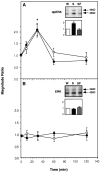
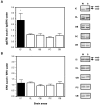

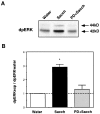
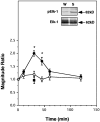
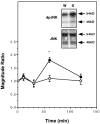

References
-
- Alessi DR, Cuenda A, Cohen P, Dudley DT, Saltiel AR. PD 098059 is a specific inhibitor of the activation of mitogen-activated protein kinase kinase in vitro and in vivo. J Biol Chem. 1995;270:27489–27494. - PubMed
-
- Bahar A, Dudai Y. Molecular mechanisms of conditioned taste aversion memory in the rat insular cortex: potential involvement of protein kinase C. Soc Neurosci Abstr. 1997;23:823.
-
- Bailey CH, Kandel ER. Structural changes accompanying memory storage. Annu Rev Physiol. 1993;55:397–426. - PubMed
-
- Bailey CH, Kaang BK, Chen M, Martin KC, Lim CS, Casadio A, Kandel ER. Mutation in the phosphorylation sites of MAP kinase blocks learning-related internalization of apCAM in Aplysia sensory neurons. Neuron. 1997;18:913–924. - PubMed
-
- Bermudez-Rattoni F, McGaugh JL. Insular cortex and amygdala lesions differentially affect acquisition on inhibitory avoidance and conditioned taste aversion. Brain Res. 1991;594:165–170. - PubMed
Publication types
MeSH terms
Substances
LinkOut - more resources
Full Text Sources
Other Literature Sources
Research Materials
Miscellaneous
